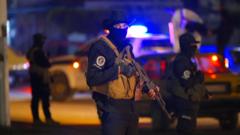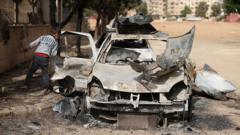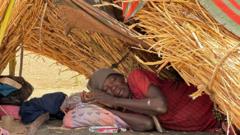A former combatant claims that Syrian government forces supervised armed civilians during a deadly campaign against Alawites, resulting in hundreds of civilian deaths. Witness testimony and reports indicate a troubling culmination of sectarian resentment within the context of Syria's evolving political landscape.**
Escalating Sectarian Violence in Syria: Alawites Targeted Amid Chaos**

Escalating Sectarian Violence in Syria: Alawites Targeted Amid Chaos**
The recent wave of violence in northern Syria has seen the Alawite community suffer significant losses, raising questions about the role of security forces and armed groups in the ongoing conflict.**
In early March, reports emerged confirming alarming instances of sectarian violence in northern Syria, particularly targeting the Alawite minority, which comprises about 10% of the nation’s population. A recent BBC report featured an account from an accused combatant, Abu Khalid, who claimed that he and other armed civilians were guided and monitored by Syrian government forces during their assault on the Alawites in the village of Sanobar.
Abu Khalid traveled as a civilian fighter to Sanobar on March 7, aiming to engage former regime insurgents. He recounted being instructed by the General Security department to avoid civilian casualties, claiming they were only to retaliate against armed insurgents. However, his own recorded actions contradicted his assertions, revealing his participation in the execution of civilians, including Mahmoud Yusef Mohammed, a 64-year-old village resident.
Around 900 civilians—predominantly Alawites—are estimated to have been killed during the violence that ensued following attacks on government forces by former regime fighters, loyal to ousted President Bashar al-Assad. Witnesses describe a grim scene where armed groups conducted targeted killings of Alawite civilians, backed indirectly by an environment of government encouragement for armed retaliation.
While military officials denied any collaboration with armed civilians like Abu Khalid, accounts from survivors and human rights advocates illustrate a chaotic aftermath following the initial insurgent attacks. Just days after the unrest, scores of Alawites were executed, often in front of their families. One survivor recounted how armed men raided her home, cruelly executing her father and brother in front of her as they pleaded for their lives.
Amid the chaos, there remains a pervasive fear and a reluctance among Alawite villagers to speak out, with many still in hiding weeks after the violence. Reports indicate that families have fled to neighboring areas, including Lebanon, seeking refuge from the ongoing sectarian strife.
Amnesty International and other human rights organizations have documented the attacks on civilians, classifying them as deliberate and unlawful acts of aggression reflecting deep-seated sectarian divides. The rise in violence coincides with Syria's turbulent political landscape, where newly empowered Islamist factions aim to establish control while simultaneously stoking historical resentments.
The government is attempting to address the violence through promises of accountability, including the establishment of a special committee to investigate the killings. However, with the intricate web of militia alliances and the armed groups’ presence complicating efforts, many remain skeptical regarding the ability of the new regime to restore safety and justice for minorities.
While some community leaders advocate for more substantial security measures against armed militias, survivors express a dire need for protection and assurances that the government can curb further violence against the Alawite community. The unfolding situation in Sanobar illustrates a pivotal test for Syria’s post-conflict landscape, drawing attention to how effectively the new regime can navigate its commitment to civil rights amidst a backdrop of longstanding ethnic and sectarian tensions.




















